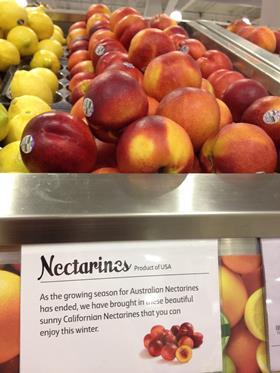
The California stonefruit industry received welcome news last July when Australia finally granted market access for peaches and nectarines. It was a ten-year process but it appears to have been worth the wait as approximately 250,000 cartons were shipped over a six-week period.
By all accounts, the debut shipments made a positive first impression.
“The Australian trade was generally pleased with the quality of product received last year,” said Marcy Martin, director of trade for the California Grape & Tree Fruit League.
Garth Lockyer of major Australian importer Valleyfresh confirmed Martin’s view, noting that Australian consumers were particularly impressed by the California offering. “The quality is so good it delivers a great consumer experience – many consumers had never eaten stonefruit like it in terms of size and flavour.”
Access was secured deep into the California season last year, with delays to the release of protocols preventing shipments from starting until mid-August. This year, with a full season of production to work with, Lockyer expects an upsurge in imports.
“We’ll be looking at full programmes spanning the range of varieties for our retail and wholesale customers,” said Lockyer.
Sydney-based importer Fresh Produce Group was among the first to bring in new-season fruit this year, with its shipments of non pre-cleared fruit arriving at the beginning of May. “We’ve been bringing in white-flesh nectarines and yellow-flesh peaches and the early arrivals have been very good,” said executive chairman Rob Nugan.
While FOB prices were high on early shipments, Nugan expects them to come down, particularly as volumes rise with many more suppliers and receivers getting on the act. “There’s a whole lot of activity with new players coming in on both ends of the deal, so volumes will be up significantly,” he said.
Last year, retail price points for California stonefruit in Australia dipped below A$10 per kg as the start of trade coincided with the season’s lowest FOB price points while the Australian dollar was relatively strong. “Prices got down to around A$9-10 per kg last year and I expect that’s where the business will be trending this year,” said Nugan.
While all shipments must undergo methyl bromide fumigation, which can damage the fruit, debut shipments last year held up relatively well to the protocol.
“Methyl bromide treatment no doubt caused some minor issues such as rare cases of fumigation burn, but generally speaking it was a great start to a new import category and we are obviously very excited about the season ahead,” said Adam Leslie of Sydney-based importer Fresh Solutions Group.
Lockyer was also pleasantly surprised by outturns after fumigation, but he added that selecting the right varieties is key. “Certain varieties will handle it better than others, but even the peach arrivals were outstanding last year,” he says.
While shipments have been confined to nectarines and peaches to date, importers are optimistic that the protocol will be expanded to include plums and pluots during the current season.
“There is the prospect of plums and plumcots being added to the list and if they’re allowed in it will enable us to expand the offering to consumers here,” said Nugan. “The Americans have a whole range of plums that are likely to appeal to Australian consumers.”
Indeed, importers see great potential to develop the stonefruit category in Australia, with imports likely to continue through October when domestic production comes on-stream again.
According to the USDA’s Foreign Agricultural Service, the Australian market has the potential to reach US$50m in sales for the California industry within five years.



